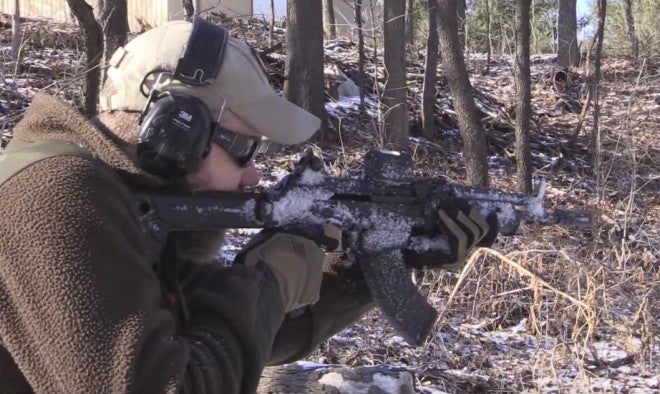Debris testing has been done to death. Here at TFB, we’ve covered mud and sand tests conducted by InRange TV, Guns & Ammo TV, and the Military Arms Channel on everything from the AK, AR-15 to the Vz. 58. So what about ice, instead?
Tim of the Military Arms Channel has posted a video on his channel of a test between his Colt 6920, SIG MCX, Beretta ARX-100, and a Krebs AC-15. The test is below, with discussion after:
The results of the test was as follows:
–
MCX – Safety very stiff, fires all 30 rounds but doesn’t lock open, sluggish operation, mag release frozen
ARX – Selector moved more easily, fires all 30 and locks open, mag release works fine
Krebs – Safety works fine, fires first round, zhukov stock broke when attempting mortar gun open, fired second round and bolt stuck again, then fires all 30 rounds. Mag release works fine
Colt – Safety very stiff, trigger reset sluggish fires all 30 no lock open, sluggish operation, mag release frozen
–
So, as Tim notes at the end of the video, this was not the most scientific test ever. Debris tests are hard enough to conduct consistently, but testing for freezing water probably takes the cake. It is very difficult to predict where water would pool and freeze inside the action, and with such a small sample size very few conclusions could be drawn about how consistently each rifle would perform. In fact, three of the rifles are put out of action in one way or another, with the ARX-100 being the only one that doesn’t suffer major obstruction, despite not having significant design differences to the MCX and AR-15 in the areas where they had problems.
For another data set, in 1984, Alaska State Trooper Jeffery Hall, acting on behalf of the Division of Alaska State Troopers, conducted a thorough test of rifles in arctic conditions. Interestingly, the AR-15 pattern weapons exhibited the same malfunctions as the Colt 6920 and SIG MCX in the MAC test, but the three AK-derived rifles in the test did not have any issues aside from one stovepipe with the FNC. Also worth noting is that the M16 in the test failed to fire five rounds (just a guess on my part – possibly due to ice in the firing pin channel). The Alaska State Trooper tests also differed from the MAC test in that it apparently was conducted with empty chambers. Although the tests performed for the Alaska State Troopers selection were thorough, it should be noted that they, like the MAC tests, were not entirely scientific. That means that with either test, few firm conclusions can be drawn. What would be required to make more definitive statements about the resistance of the rifles in question versus freezing water would be extensive, repeated testing with a larger sample size, and appropriate control subjects.
Finally, something should be said about the Zhukov stock on the Krebs AC-15. While I was not expecting the stock to fail, the polymer used by Magpul for their magazines and furniture has received a reputation for brittleness in cold conditions. This has held true in my experience, as several of my Magpul PMag Gen 2 magazines broke while shooting in freezing conditions several years ago when I lived in a colder climate. This doesn’t mean that Magpul furniture or magazines are bad, but they are clearly not ideal for those who live in cold climates. With regards to the Zhukov stock in particular, its combination of probable poor cold weather durability and lackluster durability when folded make it not my first choice for a folding AK stock.
 Your Privacy Choices
Your Privacy Choices
